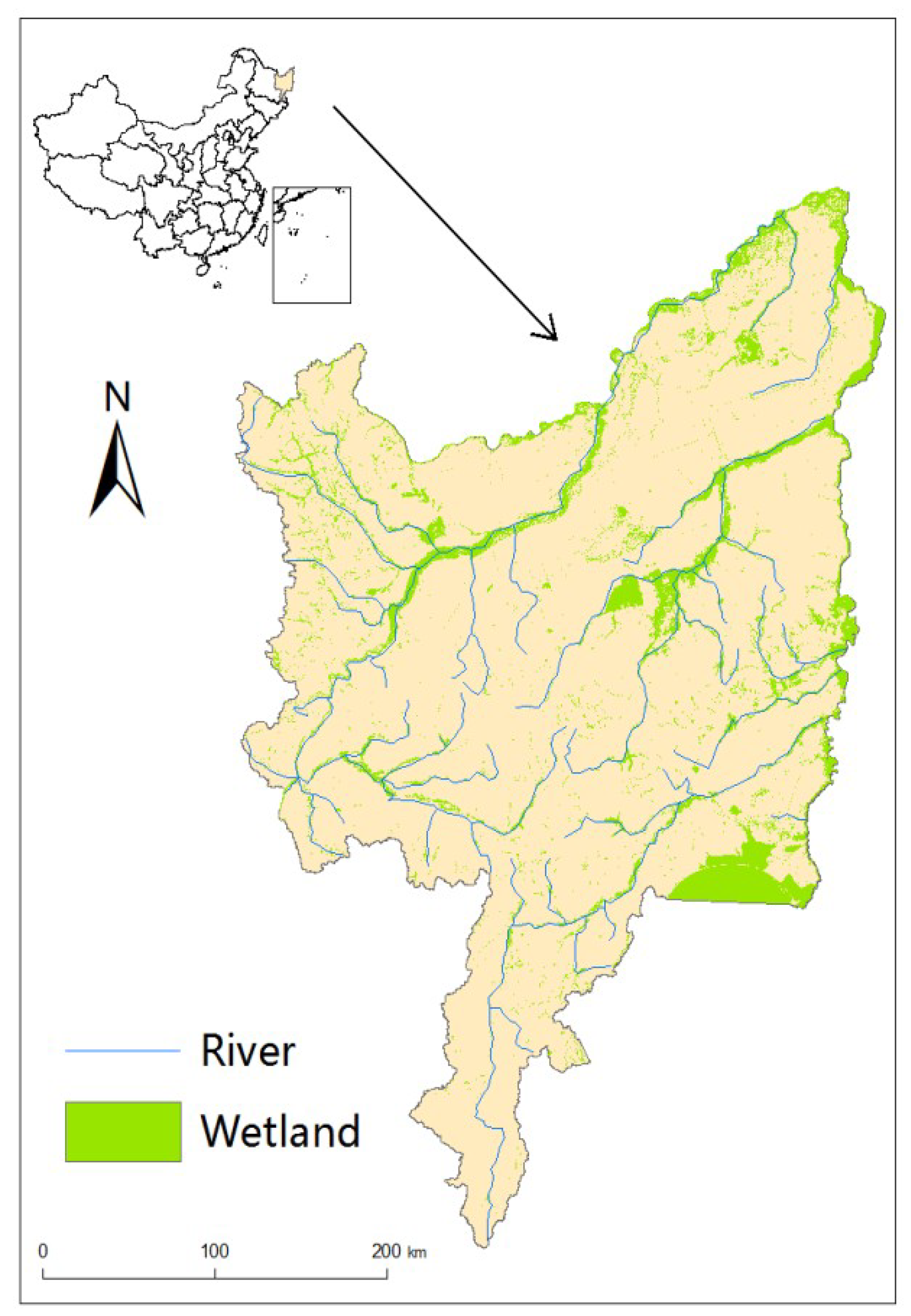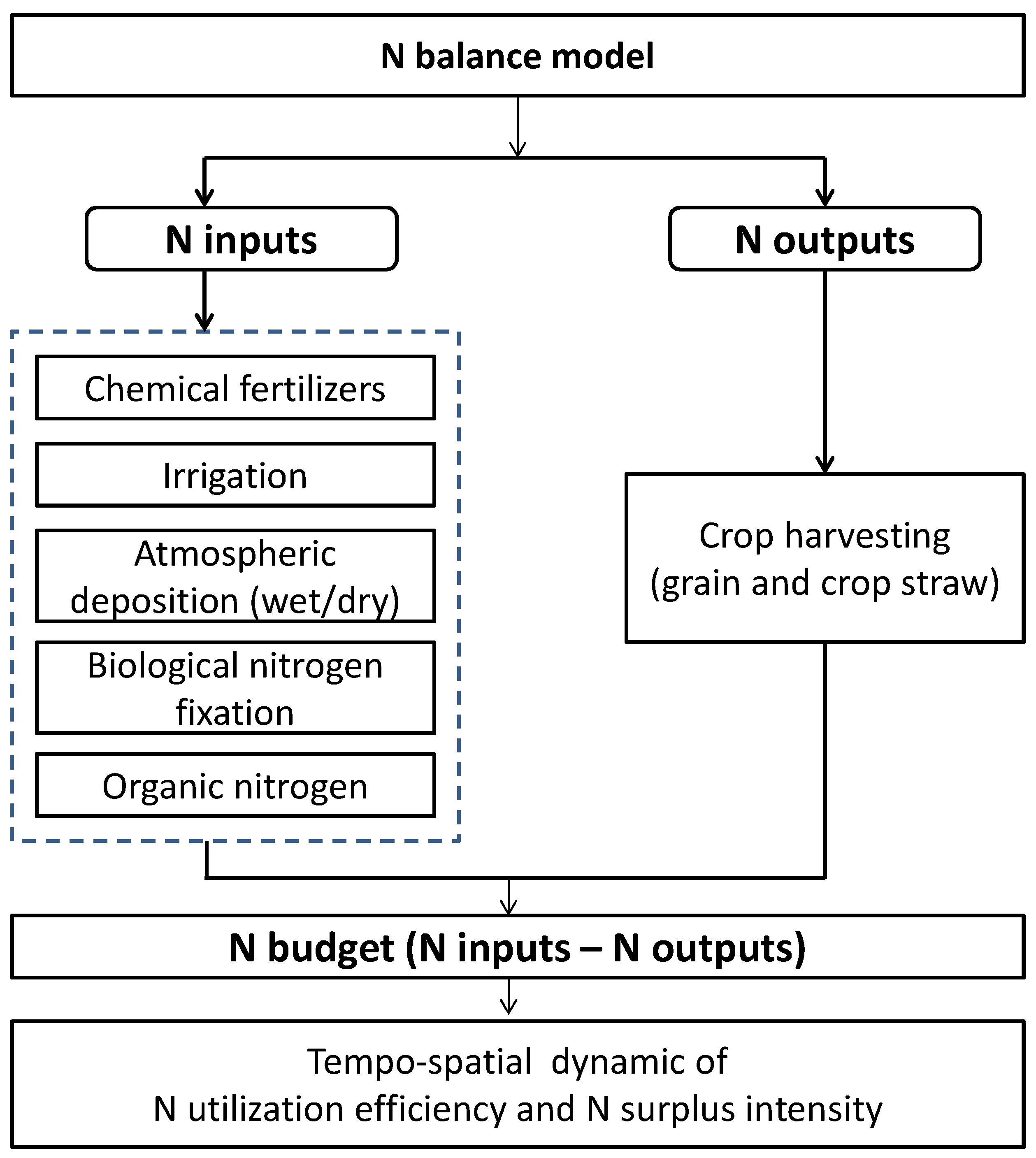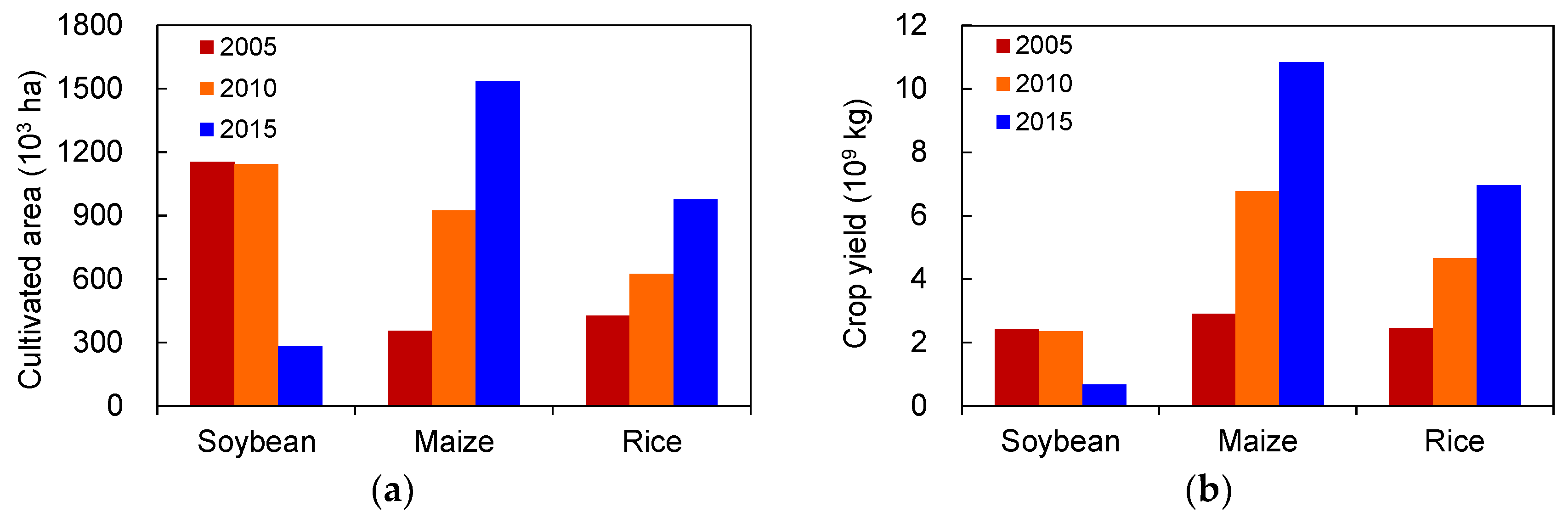Crop Structure Changes Altered the Cropland Nitrogen Balance between 2005 and 2015 on the Sanjiang Plain, China
Abstract
:1. Introduction
2. Materials and Methods
2.1. Study Area
2.2. County-Level Database
2.3. Nitrogen Balance
2.4. Nitrogen Surplus Intensity, Nitrogen Use Efficiency
2.5. Statisical Analysis
2.6. Uncertainty Analysis of N Budgets
3. Results
3.1. Agricultural Development and Crop Yield
3.2. Nitrogen Input, Output, and Agricultural Balance
3.3. Spatial Patterns of Nitrogen Use Efficiency and Nitrogen Surplus Intensity
3.4. Impacts of Agricultural Development on NUE
3.5. Uncertainty Analysis of N Budgets
4. Discussion
Author Contributions
Funding
Conflicts of Interest
References
- Cui, Z.; Zhang, H.; Chen, X.; Zhang, C.; Ma, W.; Huang, C.; Zhang, W.; Mi, G.; Miao, Y.; Li, X.; et al. Pursuing sustainable productivity with millions of smallholder farmers. Nature 2018, 555, 363–366. [Google Scholar] [CrossRef] [PubMed]
- Chen, X.; Cui, Z.; Fan, M.; Vitousek, P.; Zhao, M.; Ma, W.; Wang, Z.; Zhang, W.; Yan, X.; Yang, J.; et al. Producing more grain with lower environmental costs. Nature 2014, 514, 486–489. [Google Scholar] [CrossRef] [PubMed]
- Vitousek, P.M.; Naylor, R.; Crews, T.; David, M.B.; Drinkwater, L.E.; Holland, E.; Johnes, P.J.; Katzenberger, J.; Martinelli, L.A.; Matson, P.A.; et al. Nutrient imbalances in agricultural development. Science 2009, 324, 1519–1520. [Google Scholar] [CrossRef] [PubMed]
- Özbek, F.Ş.; Leip, A. Estimating the gross nitrogen budget under soil nitrogen stock changes: A case study for Turkey. Agric. Ecosyst. Environ. 2015, 205, 48–56. [Google Scholar] [CrossRef]
- Li, J.; He, Z.B.; Du, J.; Zhao, L.W.; Chen, L.F.; Zhu, X.; Lin, P.F.; Fang, S.; Zhao, M.M.; Tian, Q.Y. Regional Variability of Agriculturally-Derived Nitrate-Nitrogen in Shallow Groundwater in China, 2004–2014. Sustainability 2018, 10, 1393. [Google Scholar] [CrossRef]
- Ju, X.T.; Xing, G.X.; Chen, X.P.; Zhang, S.L.; Zhang, L.J.; Liu, X.J.; Cui, Z.L.; Yin, B.; Christie, P.; Zhu, Z.L.; et al. Reducing environmental risk by improving N management in intensive Chinese agricultural systems. Proc. Natl. Acad. Sci. USA 2009, 106, 3041–3046. [Google Scholar] [CrossRef] [PubMed] [Green Version]
- Zhang, X.; Davidson, E.A.; Mauzerall, D.L.; Searchinger, T.D.; Dumas, P.; Shen, Y. Managing nitrogen for sustainable development. Nature 2015, 528, 51–59. [Google Scholar] [CrossRef] [PubMed] [Green Version]
- Pan, D.; Kong, F.; Zhang, N.; Ying, R. Knowledge training and the change of fertilizer use intensity: Evidence from wheat farmers in China. J. Environ. Manag. 2017, 197, 130–139. [Google Scholar] [CrossRef] [PubMed]
- Zhu, Z.L.; Chen, D.L. Nitrogen fertilizer use in China—Contributions to food production, impacts on the environment and best management strategies. Nutr. Cycl. Agroecosyst. 2002, 63, 117–127. [Google Scholar] [CrossRef]
- Guo, L.; Yang, R.; Wang, D. A study on the spatial difference of farmland nitrogen nutrient budget in the Bohai Rim region, China. J. Geogr. Sci. 2012, 22, 761–768. [Google Scholar] [CrossRef]
- Sun, S.; Delgado, M.S.; Sesmero, J.P. Dynamic adjustment in agricultural practices to economic incentives aiming to decrease fertilizer application. J. Environ. Manag. 2016, 177, 192–201. [Google Scholar] [CrossRef] [PubMed]
- Kintl, A.; Elbl, J.; Lošák, T.; Vaverková, M.D.; Nedělník, J. Mixed Intercropping of Wheat and White Clover to Enhance the Sustainability of the Conventional Cropping System: Effects on Biomass Production and Leaching of Mineral Nitrogen. Sustainability 2018, 10, 336. [Google Scholar] [CrossRef]
- Cobo, J.G.; Dercon, G.; Cadisch, G. Nutrient balances in African land use systems across different spatial scales: A review of approaches, challenges and progress. Agric. Ecosyst. Environ. 2010, 136, 1–15. [Google Scholar] [CrossRef] [Green Version]
- Ha, N.; Feike, T.; Back, H.; Xiao, H.; Bahrs, E. The effect of simple nitrogen fertilizer recommendation strategies on product carbon footprint and gross margin of wheat and maize production in the North China Plain. J. Environ. Manag. 2015, 163, 146–154. [Google Scholar] [CrossRef] [PubMed]
- Liang, B.; Kang, L.; Ren, T.; Junliang, L.; Chen, Q.; Wang, J. The impact of exogenous N supply on soluble organic nitrogen dynamics and nitrogen balance in a greenhouse vegetable system. J. Environ. Manag. 2015, 154, 351–357. [Google Scholar] [CrossRef] [PubMed]
- Nilahyane, A.; Islam, M.A.; Mesbah, A.O.; Garcia, A.G. Evaluation of Silage Corn Yield Gap: An Approach for Sustainable Production in the Semi-Arid Region of USA. Sustainability 2018, 10, 252. [Google Scholar] [CrossRef]
- Shindo, J. Changes in the nitrogen balance in agricultural land in Japan and 12 other Asian Countries based on a nitrogen-flow model. Nutr. Cycl. Agroecosyst. 2012, 94, 47–61. [Google Scholar] [CrossRef]
- Van Breemen, N.; Boyer, E.W.; Goodale, C.L.; Jaworski, N.A.; Paustian, K.; Lajtha, K.; Mayer, B.; Van Dam, D.; Howarth, R.W.; Nadelhoffer, K.J.; et al. Where did all the nitrogen inputs go? Fate of nitrogen in the northeastern. Biogeochemistry 2002, 57/58, 267–293. [Google Scholar] [CrossRef]
- Xiong, Z.Q.; Freney, J.R.; Mosier, A.R.; Zhu, Z.L.; Lee, Y.; Yagi, K. Impacts of population growth, changing food preferences and agricultural practices on the nitrogen cycle in East Asia. Nutr. Cycl. Agroecosyst. 2008, 80, 189–198. [Google Scholar] [CrossRef]
- Dhakal, D.; Islam, M.A. Grass-Legume Mixtures for Improved Soil Health in Cultivated Agroecosystem. Sustainability 2018, 10, 2718. [Google Scholar] [CrossRef]
- Bao, X.; Watanabe, M.; Wang, Q.; Hayashi, S.; Liu, J. Nitrogen budgets of agricultural fields of the Changjiang River basin from 1980 to 1990. Sci. Total Environ. 2006, 363, 136–148. [Google Scholar] [CrossRef] [PubMed]
- Liu, C.; Watanabe, M.; Wang, Q. Changes in nitrogen budgets and nitrogen use efficiency in the agroecosystems of the Changjiang River basin between 1980 and 2000. Nutr. Cycl. Agroecosyst. 2008, 80, 19–37. [Google Scholar] [CrossRef]
- Xing, G.X.; Zhu, Z.L. Regional nitrogen budgets for China and its major watersheds. Biogeochemistry 2002, 57/58, 405–427. [Google Scholar] [CrossRef]
- Zheng, M.; Zheng, H.; Wu, Y.; Xiao, Y.; Du, Y.; Xu, W.; Lu, F.; Wang, X.; Ouyang, Z. Changes in nitrogen budget and potential risk to the environment over 20 years (1990–2010) in the agroecosystems of the Haihe Basin, China. J. Environ. Sci. 2015, 28, 195–202. [Google Scholar] [CrossRef] [PubMed]
- Wang, Y.Y.; Yang, Q.; Wang, R.S. Simulating study on nitrogen circulation of soybean field in the Sanjiang Plain. Sci. Geogr. Sin. 1999, 19, 555–558. (In Chinese) [Google Scholar]
- Fang, Y.D.; Feng, Z.M.; Hu, Y.C.; Wang, L.L. Balance of field nitrogen nutrient input/output using GIS technology in China. Trans. Chin. Soc. Agric. Eng. 2007, 23, 35–41. (In Chinese) [Google Scholar]
- Sheldrick, W.F.; Syers, J.K.; Lingard, J. A conceptual model for conducting nutrient audits at national, regional, and global scales. Nutr. Cycl. Agroecosyst. 2002, 62, 61–72. [Google Scholar] [CrossRef]
- Szalińska, E.; Orlińska-Woźniak, P.; Wilk, P. Nitrate Vulnerable Zones Revision in Poland—Assessment of Environmental Impact and Land Use Conflicts. Sustainability 2018, 10, 3297. [Google Scholar] [CrossRef]
- Yu, H.; He, Z.; Pan, X. Wetlands shrink simulation using Cellular Automata: A case study in Sanjiang Plain, China. Procedia Environ. Sci. 2010, 2, 25–233. [Google Scholar] [CrossRef]
- Wang, Z.; Zhang, B.; Zhang, S.; Li, X.; Liu, D.; Song, K.; Li, J.; Li, F.; Duan, H. Changes of land use and of ecosystem service values in sanjiang plain, northeast china. Environ. Monit. Assess. 2006, 112, 69–91. [Google Scholar] [CrossRef] [PubMed]
- Cao, N.; Qu, D.; Chen, X.P.; Zhang, F.S.; Fan, M.S. Analysis of the contribution to non-point pollution made by balanced fertilizer in Northeast China. J. Northwest A&F Univ. (Nat. Sci. Ed.) 2006, 34, 127–133. (In Chinese) [Google Scholar]
- OECD. Environmental Performance of Agriculture in OECD Countries Since 1990; OECD: Paris, France, 2008; p. 575. [Google Scholar]
- Li, S.T.; Jin, J.Y. Characteristics of nutrient input/output and nutrient balance in different regions of China. Sci. Agric. Sin. 2011, 44, 4207–4229. (In Chinese) [Google Scholar]
- Smil, V. Nitrogen in crop production: An account of global flows. Glob. Biogeochem. Cycl. 1999, 13, 647–662. [Google Scholar] [CrossRef] [Green Version]
- Sun, Z.G.; Liu, J.S. Nitrogen cycling of atmosphere-plant-soil system in the typical Calamagrostis angustifolia wetland in the Sanjiang Plain, Northeast China. J. Environ. Sci. 2007, 19, 986–995. [Google Scholar] [CrossRef] [Green Version]
- Lovett, G.M.; Lindberg, S.E. Atmospheric deposition and canopy interactions of nitrogen in forests. Can. J. For. Res. 1993, 23, 1603–1616. [Google Scholar] [CrossRef]
- Lu, R.K.; Liu, H.X.; Wen, D.Z.; Qin, S.W.; Zheng, J.Y.; Wang, Z.Q. Nutrient cycling and balance of agricultural ecosystem in different typical regions of China II: Parameters of nutrient input to farmland, Chin. J. Soil Sci. 1996, 27, 151–154. (In Chinese) [Google Scholar]
- Xing, G.X.; Yan, X.Y. Direct nitrous oxide emissions from agricultural fields in China estimated by the revised 1996 IPPC guidelines for national greenhouse gases. Environ. Sci. Policy 1999, 2, 355–361. [Google Scholar] [CrossRef]
- Ju, X.T.; Gu, B.J. Indexes of nitrogen management. Acta Pedol. Sin. 2017, 54, 281–296. (In Chinese) [Google Scholar]
- Ti, C.T.; Pan, J.J.; Xia, Y.Q.; Yan, X.Y. A nitrogen budget of mainland China with Spatial and temporal variation. Biogeochemistry 2012, 108, 381–394. [Google Scholar] [CrossRef]
- Wang, L.J.; Zheng, H.; Zhao, H.; Robinson, B.E. Nitrogen balance dynamics during 2000–2010 in the Yangtze River Basin croplands, with special reference to the relative contributions of cropland area and synthetic fertilizer N application rate changes. PLoS ONE 2017, 12, e0180613. [Google Scholar] [CrossRef] [PubMed]
- Lord, E.I.; Anthony, S.G.; Goodlass, G. Agricultural nitrogen balance and water quality in the UK. Soil Use Manag. 2002, 18, 363–369. [Google Scholar] [CrossRef]
- Sun, B.; Shen, R.P.; Bouwman, A.F. Surface N Balances in Agricultural Crop Production Systems in China for the Period 1980–2015. Pedosphere 2008, 18, 304–315. [Google Scholar] [CrossRef]
- Hou, Y.; Gao, Z.; Heimann, L.; Roelcke, M.; Ma, W.; Nieder, R. Nitrogen balances of smallholder farms in major cropping systems in a peri-urban area of Beijing, China. Nutr. Cycl. Agroecosyst. 2012, 92, 347–361. [Google Scholar] [CrossRef]
- Qiu, J.J.; Li, H.; Wang, L.G. Simulation of nitrogen level and balance in Cropland in China. Trans. Chin. Soc. Agric. Eng. 2008, 24, 40–44. (In Chinese) [Google Scholar]
- Wang, X.; Feng, A.; Wang, Q.; Wu, C.; Liu, Z.; Ma, Z.; Wei, X. Spatial variability of the nutrient balance and related NPSP risk analysis for agro-ecosystems in China in 2010. Agric. Ecosyst. Environ. 2014, 193, 42–52. [Google Scholar] [CrossRef]
- Zeng, X.B.; Huang, X.X.; Liu, Z.G.; Li, L.F.; Yang, J.B. Effects of the period of wetland reclamation on the character of soil profiles, C and N contents in Sanjing Plain. Sci. Agric. Sin. 2006, 39, 1186–1195. (In Chinese) [Google Scholar]
- Ouyang, W.; Xu, Y.; Hao, F.; Wang, X.; Siyang, C.; Lin, C. Catena Effect of long-term agricultural cultivation and land use conversion on soil nutrient contents in the Sanjiang Plain. Catena 2013, 104, 243–250. [Google Scholar] [CrossRef]
- Sun, Z.G.; Liu, J.S.; Li, X.H. Changes of nitrogen storage in soil under different land uses in the Sangjiang Plain. Syst. Sci. Compr. Stud. Agric. 2008, 24, 270–274. (In Chinese) [Google Scholar]
- Yu, Y.; Guo, Z.; Wu, H.; Kahmann, J.A.; Oldfield, F. Spatial changes in soil organic carbon density and storage of cultivated soils in China from 1980 to 2000. Glob. Biogeochem. Cycl. 2009, 23, GB2021. [Google Scholar] [CrossRef]
- Song, K.S.; Liu, D.W.; Wang, Z.M.; Zhang, B.; Jin, C.; Li, F.; Liu, H.J. Analysis of cultivated land dynamics in the past 50 years in Sanjiang Plain and its driving forces. J. Soil Water Conserv. 2008, 22, 75–81. (In Chinese) [Google Scholar]
- Zhang, H.Q.; Ma, F.C. Fluctuation analysis and evaluation of grain production in Heilongjiang Province. J. Heilongjiang Bayi Agric. Univ. 2013, 25, 97–101. (In Chinese) [Google Scholar]
- Li, X.Z.; Qiao, J. Fluctuation of soybean sowing area in Northeast China and cause analysis. Xinjiang State Farms Econ. 2009, 4, 6–12. (In Chinese) [Google Scholar]
- Yu, J.B.; Qiao, J.; Qiao, Y.L. On soybean industry development under import impact in China. Res. Agric. Mod. 2005, 26, 213–216. (In Chinese) [Google Scholar]





| Parameter | 2005 | 2010 | 2015 | 2015–2005 (%) |
|---|---|---|---|---|
| Population (106) | 7.2 | 7.4 | 6.3 | −12.7 |
| Rural population (106) | 3.3 | 3.2 | 3.0 | −11.1 |
| Livestock population (cattle, pigs, sheep) (106) | 7.0 | 8.3 | 8.5 | 20.6 |
| Cultivated land area (105 ha) | 21.9 | 28.6 | 30.4 | 39.2 |
| Chemical fertilizers (104 t N) | 18.1 | 24.9 | 26.2 | 45.1 |
| Total food grain production (106 kg) | 7763.5 | 13,783.0 | 18,464.8 | 137.8 |
| Productivity of food grains (kg/ha) | 4012.1 | 5120.2 | 6616.5 | 64.9 |
| N fertilizer rate (kg/ha) | 82.6 | 86.9 | 86.2 | 4.3 |
| N Budget Term | 2005 | 2010 | 2015 | |||
|---|---|---|---|---|---|---|
| Amount (104 t N) | % of Input | Amount (104 t N) | % of Input | Amount (104 t N) | % of Input | |
| Input | ||||||
| Chemical fertilizers | 18.1 | 38.3 | 24.9 | 42.3 | 26.2 | 51.0 |
| Irrigation | 0.9 | 1.9 | 1.7 | 2.9 | 2.2 | 4.2 |
| Atmospheric deposition | 3.3 | 7.0 | 4.3 | 7.3 | 4.6 | 9.0 |
| Biological fixation | 18.5 (17.3–19.7) | 39.2 | 20.11 (18.9–21.3) | 34.2 | 10.6 (10.3–10. 9) | 20.6 |
| Non-symbiotic | 2.4 | 4.2 | 6.7 | |||
| Symbiotic | 16.1 (14.8–17.3) | 15.9 (14.7–17.2) | 3.9 (3.6–4.2) | |||
| Recycled N | 6.4 | 13.6 | 7.8 | 13.3 | 7.9 | 15.4 |
| Animal waste | 3.8 | 4.1 | 4.0 | |||
| Human waste | 0.6 | 0.6 | 0.2 | |||
| Crop residue | 2.1 | 3.2 | 3.7 | |||
| Total input | 47.2 (46.0–48.4) | 58.8 (57.6–60.1) | 51.5 (51.2–51.8) | |||
| Output | ||||||
| Harvested crops | ||||||
| Wheat | 0.3 | 0.02 | 0 | |||
| Maize | 6.3 | 17.5 | 28.0 | |||
| Rice | 4.2 | 6.8 | 10.2 | |||
| Soybeans | 20.0 | 19.7 | 5.4 | |||
| Tuber crops | 0.1 | 0.1 | 0.3 | |||
| Oil crops | 0.4 | 1.3 | 0.3 | |||
| Sugar beet | 0.2 | 0.1 | 0 | |||
| Tobacco | 0.1 | 0.2 | 0.1 | |||
| Vegetables | 1.4 | 0.7 | 0.5 | |||
| Fruits | 0.1 | 0.2 | 0.02 | |||
| Total output | 33.0 | 46.4 | 44.8 | |||
| Budget (input–output) | 14.2 | 12.4 | 6.7 | |||
| Nitrogen surplus intensity (kg/ha) | 65.0 | 43.5 | 22.2 | |||
| Nitrogen use efficiency (%) | 69.9 | 78.8 | 86.9 | |||
| Coefficients | Standard Error | |
|---|---|---|
| Constant | 92.020 | 86.834 |
| NUE in 2005 | −0.990 * | 0.393 |
| N input per unit area in 2005 | −0.372 * | 0.161 |
| Change in N input per unit area between 2005 and 2015 | −0.341 *** | 0.081 |
| Area percentage under soybean in 2005 | 0.552 | 1.138 |
| Change in area percentage under soybean between 2005 and 2015 | 0.446 | 0.938 |
| Area percentage under rice in 2005 | 0.416 | 0.699 |
| Change in area percentage under rice between 2005 and 2015 | 0.164 | 0.543 |
| Area percentage under maize in 2005 | 1.092 | 1.119 |
| Change in area percentage under maize between 2005 and 2015 | 0.781 † | 0.424 |
| R2 | 0.554 | - |
| N | 22 | - |
© 2018 by the authors. Licensee MDPI, Basel, Switzerland. This article is an open access article distributed under the terms and conditions of the Creative Commons Attribution (CC BY) license (http://creativecommons.org/licenses/by/4.0/).
Share and Cite
Yang, C.; Zheng, H.; Huang, B.; Li, R.; Ouyang, Z.; Li, C. Crop Structure Changes Altered the Cropland Nitrogen Balance between 2005 and 2015 on the Sanjiang Plain, China. Sustainability 2018, 10, 4011. https://doi.org/10.3390/su10114011
Yang C, Zheng H, Huang B, Li R, Ouyang Z, Li C. Crop Structure Changes Altered the Cropland Nitrogen Balance between 2005 and 2015 on the Sanjiang Plain, China. Sustainability. 2018; 10(11):4011. https://doi.org/10.3390/su10114011
Chicago/Turabian StyleYang, Chunxia, Hua Zheng, Binbin Huang, Ruonan Li, Zhiyun Ouyang, and Cong Li. 2018. "Crop Structure Changes Altered the Cropland Nitrogen Balance between 2005 and 2015 on the Sanjiang Plain, China" Sustainability 10, no. 11: 4011. https://doi.org/10.3390/su10114011





